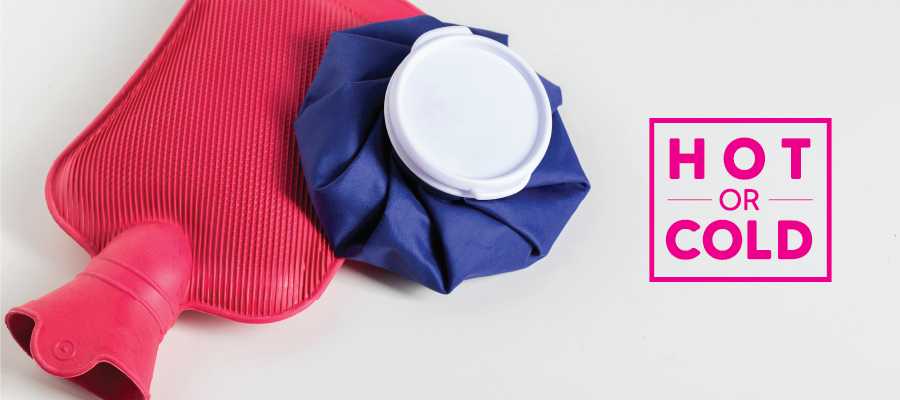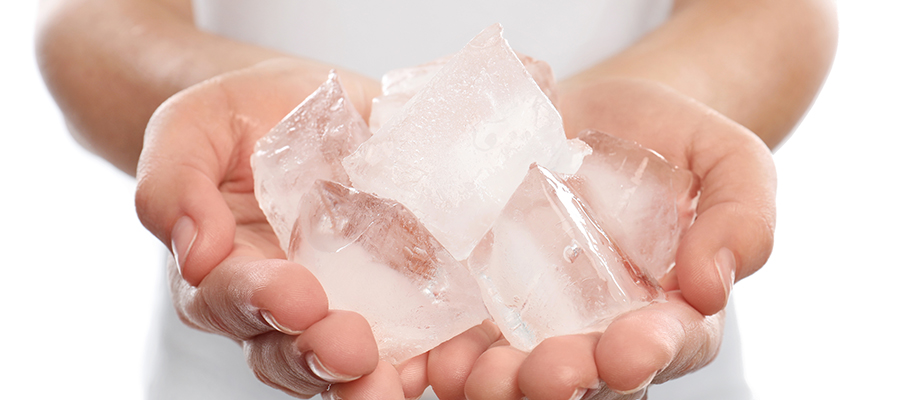Both cold therapy and heat therapy can ease hand pain and aid recovery from injury or hand surgery. Each can work better for certain types of hand pain. Below, you will find out which one to use and when.

Cold Therapy or Heat Therapy? – How to Choose
When our delicate hand structures are painful, they can make movements challenging and we might also lose power and strength in our fingers, hands, and wrists.
At home, it is common to use heat or cold to treat hand pain, stiffness, swelling, and injuries. Hot and cold treatments may also be recommended for pre- and post-surgery as well as during recovery. While the cold is a great go-to for pain and swelling, heat may ease stiffness and hasten healing.
Types of Hand Pain
Different types of hand pain respond differently to heat or cold. It helps to know the source of our hand pain to choose the best warm or cold treatment options.
The intricate anatomy of our fingers, hands, and wrists is made up of bones, joints, tendons, nerves, and connective tissues. The causes of hand pain might be inflammation, nerve pain, strains, sprains, or a combination of causes. Several chronic conditions may affect our hands as well.
Arthritis is a common source of hand pain. The smooth cartilage between our bones cushions our bone ends, making movement comfortable. With age, overuse, or other health issues, deterioration of this cartilage causes pain and inflammation, generally known as arthritis. Arthritis diagnosis may be further classified as osteoarthritis, rheumatoid arthritis, or other types of arthritis depending on causes and symptoms.
Other sources of hand pain may relate to conditions such as carpal tunnel syndrome, trigger finger, DeQuervain’s tenosynovitis, injury, cysts, or fractures. Each may benefit from cold treatments or heat treatments. Used together, both hot and cold treatments, known as contrast therapy, are beneficial for some situations. Another method, where cold therapy is followed by heat therapy, can benefit hand pain and recovery as well.
Best of Both – Reusable Hot and Cold Packs

There are many options for treating hand pain at home. Following doctor’s recommendations, wound care strategies, and medicine routines can be augmented with hot and cold therapy.
Many types of dual-purpose hot and cold packs are available. Some come with soft covers and straps to make them more comfortable and hold them in place. It’s a great idea to have a couple of these on hand to provide pain relief when needed. To reduce pain and swelling use cold packs which are cooled in a freezer. For soothing heat, the therapy packs can be heated in the microwave or in hot water to ease muscle aches and stiffness.
A therapeutic example of using both hot and cold treatment would be for conditions such as osteoarthritis or carpal tunnel syndrome. You can use cold to numb the pain and reduce swelling. Use heat to soothe and relax tense muscles.
Cold Freezes Pain and Shrinks Swelling

How Cold Affects Hand Pain
Cold affects hand pain in several ways. First, it will reduce blood flow, known as vasoconstriction. It will help slow bleeding if that is required after an injury. Cold slows down the molecules in tissues and constricts blood vessels, slowing nerve activity. These actions numb hand pain and reduce swelling.
When Cold Therapy is Best
Cold therapy reduces swelling and inflammation while numbing pain and tenderness. It is best to use cold therapy during the early stages of hand pain and after performing exercises. After surgery, cold therapy may be recommended initially to manage inflammation.
Cold Therapy Best Practices
At home, you can perform cold therapy to numb pain and reduce swelling of your hands, fingers, and wrists using a variety of methods. Make an ice pack by placing a damp towel in a plastic bag and putting it in the freezer for 15 to 20 minutes. Another at-home ice pack can simply be made by putting ice in a plastic bag and wrapping it in a towel.
Apply cold therapy for 15 to 20 minutes with a half-hour break in between for best results. Always use a towel or fabric between your skin and the ice pack to avoid skin injuries.
When Not to Use Cold Therapy
Cold therapy is not helpful before physical activity because the ice will stiffen muscles and can make tension and spasms worse. Short periods of ice therapy are best, so it is not recommended to use cold therapy while sleeping. Because cold therapy reduces blood flow, it can also slow down the healing process. For this reason, use cold therapy only just after an injury and follow your hand surgeon’s recommendations. Extreme cold and ice can feel uncomfortable or cause frostbite injury. Do stop using ice if you feel undue pain and discomfort.
The Healing Power of Heat

How Heat Affects Hand Pain
Heat therapy increases circulation. It is a vasodilator that expands the blood vessels. With the increased blood flow and faster molecules in the tissues, oxygen and nutrients are delivered to the injured area faster. This speeds up the healing process. The soothing warmth relieves stiff joints and muscles, reducing pain, cramping, and aching muscles.
When Heat Therapy is Best
Just like warming up before a workout, heat therapy increases blood flow which loosens muscles and makes joints more flexible. Heat therapy is best used before physical activity and working with our hands. After overworking our hands, regular blood flow may not be enough to eliminate the subsequent buildup of chemicals such as lactic acid that lead to aching muscles. Using heat after exercise can relieve tired, overworked muscles as well.
Heat Therapy Best Practices
Soaking hands in warm water, using a warm compress of moist heat, or a heating pad of dry heat are ways to introduce heat therapy for our hands. Heat can be applied for 20 to 60 minutes at a time. Follow the directions of your therapist and hand surgeon regarding their heat therapy recommendations for your personalized situation.
When Not to Use Heat Therapy
Heat therapy may increase inflammation. Our body’s natural response to injury is to protect the area with inflammation. But too much swelling slows down healing. Heat should be avoided for the first 48 hours after an injury so that it does not make the inflammation worse.
Because heat therapy increases blood flow, it should not be used on new wounds as it may not allow the wound to stop bleeding properly. Heat therapy should be warm and soothing, not so hot that it is painful in any way.
Special Therapy Treatments At CHARMS

CHARMS offers speciality heat and cold treatments for our hands. Therapeutic ultrasound delivers ultrasonic waves through our deep tissues to speed up molecules for soothing, deep-healing heat. Our therapists provide Paraffin wax baths to apply moist, relaxing heat to aid in relieving our hands, fingers, and wrists.
At CHARMS, our hand therapists provide the highest level of service and care to ensure your visit with us is a pleasant one.